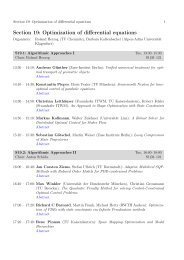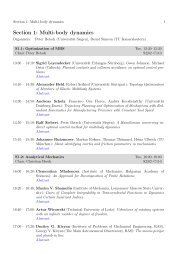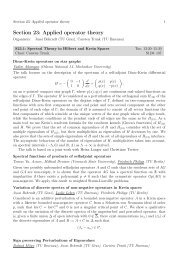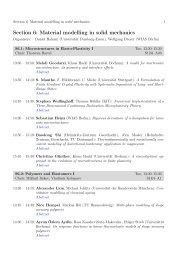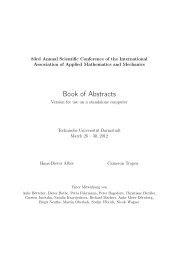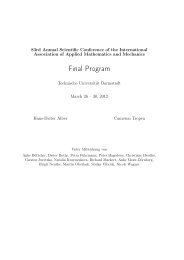Section 6: Material modelling in solid mechanics - GAMM 2012
Section 6: Material modelling in solid mechanics - GAMM 2012
Section 6: Material modelling in solid mechanics - GAMM 2012
You also want an ePaper? Increase the reach of your titles
YUMPU automatically turns print PDFs into web optimized ePapers that Google loves.
10 <strong>Section</strong> 6: <strong>Material</strong> <strong>modell<strong>in</strong>g</strong> <strong>in</strong> <strong>solid</strong> <strong>mechanics</strong><br />
characterised us<strong>in</strong>g multi-level of protuberance-on-protuberance profiles. The effects of the surface<br />
roughness are <strong>in</strong>vestigated with respect to the identified model parameters us<strong>in</strong>g a surface<br />
topography with one-level or multi-level profiles approximated by a s<strong>in</strong>e function. The results are<br />
expected to offer a deep <strong>in</strong>sight <strong>in</strong>to characteris<strong>in</strong>g the real surface roughness numerically.<br />
<strong>Material</strong> force computation for the thermo-mechanical response of dynamically loaded<br />
elastomers<br />
Ronny Behnke, Michael Kaliske (TU Dresden)<br />
Elastomers are widely used <strong>in</strong> our today’s life. The material is characterized by large deformability<br />
upon failure, elastic and time dependent as well as non-time dependent effects which can<br />
be also a function of temperature. In addition, cyclically loaded components show heat built-up<br />
which is due to dissipation. As a result, the temperature evolution of an elastomeric component<br />
can strongly <strong>in</strong>fluence the material properties and durability characteristics. Represent<strong>in</strong>g best<br />
the real thermo-mechanical behaviour of an elastomeric component <strong>in</strong> its design process is one<br />
motivation for the use of sophisticated, coupled material approaches with<strong>in</strong> numerical simulations.<br />
In order to assess the durability characteristics, for example regard<strong>in</strong>g crack propagation, the<br />
material forces (configurational forces) are one possible approach to be applied. In the present<br />
contribution, the implementation of material forces for a thermo-mechanically coupled material<br />
model <strong>in</strong>clud<strong>in</strong>g a cont<strong>in</strong>uum mechanical damage (CMD) approach is demonstrated <strong>in</strong> the context<br />
of the F<strong>in</strong>ite Element Method (FEM). Special emphasis is given to material forces result<strong>in</strong>g<br />
from <strong>in</strong>ternal variables (viscosity and damage variables), temperature field evolution and dynamic<br />
load<strong>in</strong>g. Us<strong>in</strong>g an example of an elastomeric component, for which the material model parameters<br />
have been previously identified by a uniaxial extension test, material forces are evaluated quantitatively.<br />
The <strong>in</strong>fluence of each contribution (<strong>in</strong>ternal variables, temperature field and dynamics)<br />
is illustrated and compared to the overall material force response.<br />
S<strong>in</strong>gle and multiscale aspects of the model<strong>in</strong>g of cur<strong>in</strong>g polymers<br />
Alexander Bartels ∗ , Sandra Kl<strong>in</strong>ge ∗ , Klaus Hackl ∗ , Paul Ste<strong>in</strong>mann ∗∗ (Universität Bochum, Universität<br />
Erlangen-Nürnberg)<br />
With<strong>in</strong> this presentation, the focus is placed on the simulation of the isochoric behavior of polymers<br />
dur<strong>in</strong>g the cur<strong>in</strong>g process. To this end, a model based on the assumption for the free<br />
energy <strong>in</strong> the form of a convolution <strong>in</strong>tegral is applied. S<strong>in</strong>ce this allows the implementation of<br />
the time dependent material parameters, the free energy is <strong>in</strong>terpreted as the total-accumulated<br />
energy. Different from this, the stra<strong>in</strong> energy is related to the current state of deformation and<br />
used to def<strong>in</strong>e the temporary stiffness. In order to avoid volume lock<strong>in</strong>g effects typical for isochoric<br />
materials, the free energy is furthermore split <strong>in</strong>to a volumetric and a deviatoric part. A<br />
multifield description depend<strong>in</strong>g on the displacements, volume change and hydrostatic pressure<br />
is <strong>in</strong>troduced as well. The model is implemented with<strong>in</strong> a s<strong>in</strong>gle- and multiscale FE program<br />
and used to simulate the behavior of homogeneous and microheterogeneous polymers. The ma<strong>in</strong><br />
property of the multiscale concept used here is that the model<strong>in</strong>g of a heterogeneous body is<br />
performed by simultaneously solv<strong>in</strong>g two boundary value problems: one related to the behavior<br />
of the macroscopic body and the other one deal<strong>in</strong>g with the analysis of the representative volume<br />
element.<br />
Influence of nano-particle <strong>in</strong>teractions on the mechanical behavior of colloidal structures<br />
<strong>in</strong> polymeric solutions<br />
Roozbeh Dargazany, Ngoc Khiêm Vu , Mikhail Itskov (RWTH Aachen)<br />
Colloidal structures <strong>in</strong>side solutions are usually considered as rigid bodies or l<strong>in</strong>ear spr<strong>in</strong>gs. Howe-



